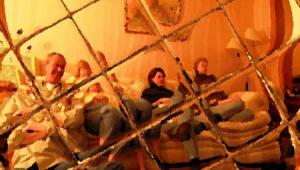Burn Baby Burn!
Some of the test results, like the "Static and Dynamic Resolution Tests" might make your eye's glaze over, but they were worth reading. Using multi-burst patterns from a signal generator at SDTV (720x480i @ 29.97 Hz) and HDTV (both 1280x720p @ 59.94 Hz and 1980x1080i @ 29.97 Hz) signal levels, All sets resolved at least 18 MHz of luminance detail. The consultant group, Roam Consultants, concluded that "720p content will display well on 768p plasmas and 1080i content will display acceptably well."
They must be British.
Fast action sports recorded off the big 4 networks onto DVR and D-VHS and played back on the plasmas were compared to a reference CRT HDTV and judged "to be as sharp and detailed on any of the test plasma TVs as on the reference CRT HDTV monitor."
The consultants did find that a set's signal processing electronics, used for de-interlacing, motion interpolation and scaling, could limit high frequency response, but that the actual plasma cells were not responsible.
A "Gamut" test, performed on out-of-the-box plasmas ("standard" or "normal" settings, and the middle color temperature, where available) with no benefit of ISF calibration showed all the sets were capable of at least 75% coverage of the standard REC-709 HDTV color gamut and SMPTE-C color gamut. Two sets achieved 90% coverage, in fact, making the results, overall, equivalent to CRT performance according to the report. A subjective note here: I think the consultants are being overly conservative in their assessment. I can't think of any plasma I've seen whose setup out-of-the-box varied much from the "pretty great" to "not too shabby" range, whereas the out-of-the-box color performance of the CRT sets an isle over is all over the map. The ability to achieve truly horrid color reproduction from pre-calibrated CRTs is legion.
Contrast tests using both full white and 16-square checkerboards, the plasmas set to their daylight or normal level (i.e., too bright), found the sets could reach ratios of 3000:1, but the average for the group was an uninspiring 500:1. Set to cinema or low level settings, the range ratios ranged from 238:1 to 576:1. Least we despair, these numbers were still well above the performance of the calibrated reference CRT: 100:1.
When it comes to black level, plasma may be close, but as yet, it's still no cigar, and the PDC, to their credit, doesn't try to hide the fact. I can attest to that as well. CRT is still the king of the dark, but, as the report states, "combined with high contrast levels, plasma TVs provide an enjoyable viewing experience for everything from sports programming to movies." Hallelujah Jake.
Viewing angles averaged 157.5 degrees with a 1 f-stop drop (50% less intensity), which is unheard of for a rear projection CRT and according to the report, on par with CRT. This would have been a great chance to take a few cheap shots at LCD panels, by the way, but the report takes the high road (less traveled).
Finally, we get to the image retention tests and I have to say, the consultants didn't "baby" the plasmas. They set the plasmas to the least forgiving "daylight" or "normal" modes and shone a 16-square checker board signal on each for 8 solid hours! Afterwards, a white pattern was put up and the set measured where the 16 squares had been. Of the five sets, only one showed absolutely no ghost imaging. Two showed a very faint image, a third was slightly more visible, but the last set had a ghost image that was easily seen and photographable.
Two other eight hour tests were repeated on the five plasmas, first a color bar pattern and then a static Fox News frame, complete with the logo that burns liberals like a Holy water spritz for Satan. In all cases the image retention varied from nearly nothing to the one bad set where ghosting was very noticeable.
"Hey, wait a minute Fred. I thought you said Plasmas didn't burn in."
That's true enough. The consultants logically concluded that "image sticking" was not brought about by burned phosphers – an irreversible condition – as would happen were a CRT fed any those signals. Instead, image retention is attributed to an accumulated electrical charge within the plasma cell walls. Turning off the sets for 24 hours eliminated the ghost images from three of the five sets completely. The remaining two sets were fed a diet of plain white for a few hours and they too cleared up.
- Log in or register to post comments





























































